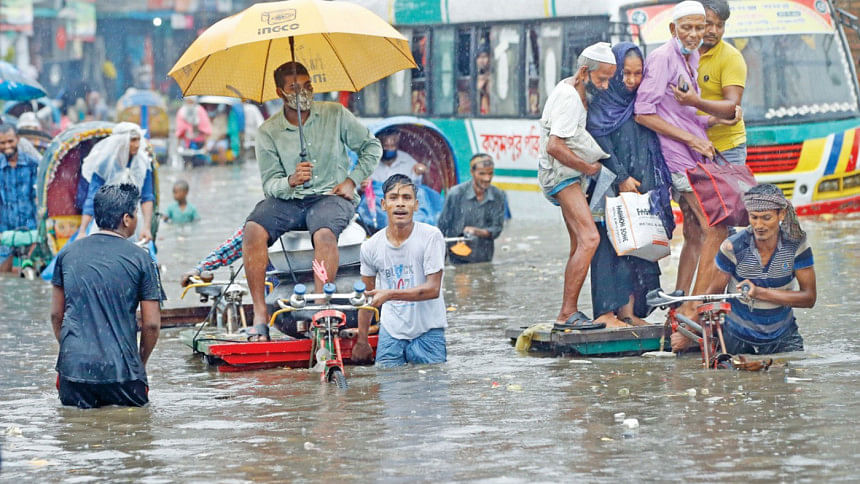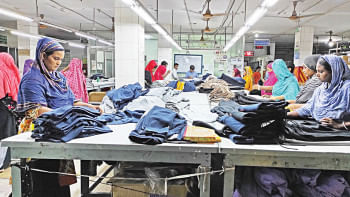Waterlogging in Dhaka: Why is there no respite in sight?

A couple of days of rain in July reminded us, once again, that the decades old waterlogging problem is far from over. There has not been any dearth in development projects undertaken to solve this problem. Such development activities have been continuing in perpetuity without yielding much benefit during the monsoon season.
According to a report in this daily from July 22, "The two city corporations in the capital have "spent" several thousand crores of taka in the last few years for the "development" of Dhaka's road infrastructure and drainage system… In the last four years, Dhaka South City Corporation (DSCC) spent over Tk 2,000 crore for the "development" of road infrastructure and drainage but there has been no visible sign of improvement when it comes to waterlogging". Waterlogging seems to have been inching towards becoming worse, year by year, due to greater difficulties in dealing with heavy downpours.
Dhaka city's drainage systems comprise of primary, secondary and tertiary drain networks. The primary drainage system includes the drains under the control of city corporations and Dhaka Water Supply and Sewerage Authority (WASA). Drains are immediate reservoirs of rain and grey water from households and businesses, and it ultimately guides waters into the secondary drainage system, which are canals under the ownership and operational control of Dhaka WASA. Canals are connected to rivers, the third tier in the city's drainage system.
There are persistent problems in both the primary and secondary drainage networks which seem to have been added to by service providers and city dwellers—the beneficiaries of the system. People's contribution has been through the abuse of the available drainage system. Drains should carry only water. Unfortunately, people push everything they can into drains and canals, choking the drainage system. Service providers' contributions have been identified to be inadequate maintenance and cleaning of different types of existing drains, not having a well-designed and well-set out perspective plan and not strictly enforcing laws against abusers of drains.
The dual control of primary drains by city corporations and Dhaka WASA is a barrier in improving the drainage system. They do not have any coordination in the operation, maintenance or construction of the primary drainage system. Drains are generally built to satisfy immediate needs of the people in the wards or as a matter of troubleshooting, without taking the long term perspective into consideration. As far as I could gather, city corporations do not have city wide maps of drain networks that have been constructed over the decades either.
Dhaka WASA has the sole responsibility of the secondary drainage network. As per the organogram, there is supposedly a dedicated Drainage Operation and Maintenance Division (with 87 staffers) and a Drainage Research and Development (R&D) Circle with 34 members. It is not known how far the Drainage R&D Circle has contributed in solving the waterlogging problem. Maintenance of canals have not been visible by performance. Looking at the severity of waterlogging in the Mirpur area and the bizarre state of canals, the Mayor of DNCC in 2019 came forward to excavate canals to lessen public suffering. The excavation exposed negligence in maintaining canals and the dire abuse of canals by the people living on either banks and in the surrounding area.
Recurring abuse of available drains by the people and public and private organisations is another cause of waterlogging. In many parts of the city, hawkers have set up illegal shops on long stretches of drains. They discharge waste, including plastic wrappers originating in their shops, into the drains. Drains in such places cannot be cleaned due to the permanent presence of hawkers. We have the bad habit of not only spitting but also littering on the streets and footpaths. Trash is regularly thrown onto the street and into the drains. Materials like sand, brick chips, cement and soil from construction sites is a grave cause of drain choking, and individuals, as well as private and public organisations, are responsible for this. Random samples of drain sludge tested in laboratories in 2018 revealed that 87 percent of the sludge contained sand and soil. Construction sites, whether private or public, do not employ appropriate "environment management measures" to prevent drain choking and air pollution.
City corporations' engineering departments construct drains, and the waste management departments have the responsibility of cleaning them. Waste management departments have to shoulder the management of 150,000 to 200,000 tons of municipal solid waste every month and sweep a couple of hundred kilometre tracts every day. It has limited capacity to clean surface drains, and lacks organisational strength and technology. It cannot chalk out year long drain cleaning programmes as there is no mapping of the city's drain network. It is feared that this lack of maintenance or irregular maintenance of underground drains might have resulted in "dead drains" under the ground.
The solutions to these problems can only come through a well-designed and well set out long term plan, combined with strong commitment and accountability in improving the drainage system. People's cooperation with utility service provider's initiatives is also important to solve these problems. But what else can be done to address these issues? The following are just food for thought, not concrete solutions, and may be adopted according to different scenarios.
There could be one single authority that has the responsibility of the city's drainage systems, such as the respective city corporations. Dhaka WASA may be relieved of the drainage responsibility and focus instead on providing pure drinking water to the public. Dhaka WASA's drainage divisions could then be merged with the city corporations.
Departments building drains should have city-wide up-to-date data to get the big picture of the drainage networks, and must not build drains on a piecemeal basis. If it is at all necessary, the data must be interfaced with the existing network. Departments building drain networks should also be given the ownership to clean and maintain them.
Regular drives should be conducted against drain abusers with punitive measures. Long term environmental education programmes for people of all occupations and professions should be in place, in order to bring about changes in negative social behaviour and stop them from abusing drains. City corporations should be the pivot of the programme where different organisations, both public and private, can contribute.
Last but not the least, safeguarding the value of taxpayers' money by ensuring accountability should be a priority. If no visible improvement in waterlogging has been noticed despite spending over Tk 2,000 crore in the last four years, the reasons behind "no visible improvement" should be looked into urgently.
Commodore Mohammad Abdur Razzak (Retd) is former Chief Waste Management Officer of Dhaka North City Corporation (DNCC). He can be reached at [email protected].

 For all latest news, follow The Daily Star's Google News channel.
For all latest news, follow The Daily Star's Google News channel. 



Comments